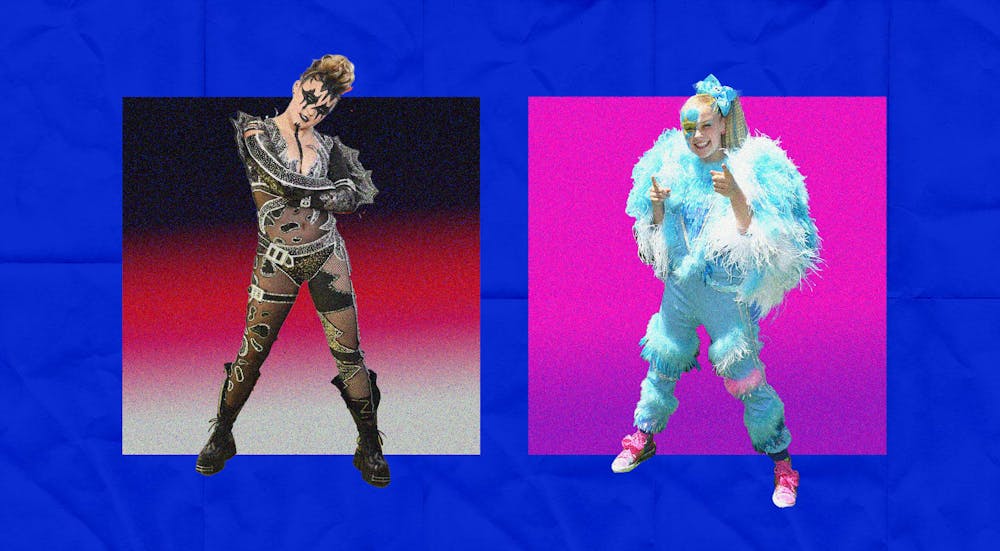This July, Jojo Siwa dropped her fourth EP, Guilty Pleasure. Months prior, Siwa defined this highly anticipated album as personal rebranding: a transition from her formerly charismatic Nickelodeon persona to a provocative, grunge influencer. RIP to the 2017 Jojo and her bows, neon jackets, and anti–bullying anthems. The two music videos accompanying Guilty Pleasure—for singles “Karma” and “Guilty Pleasure”—illustrate this artist’s reinvention of her image: Siwa now centralizes her choreography, costuming, and lyrics around her love and lust as a mature adult.
Siwa’s online persona shift surprised most members of her fandom; however, her transformation exemplifies a typical stunt of female musicians. To maintain public attention, many of these celebrities change their profile every two to five years: hair, fashion, genre, and Instagram color scheme. Recently, young adults have repurposed the term “era” to periodize an artist’s different aesthetics: These “eras” commonly correspond to album cycles. For instance, Miley Cyrus began her Bangerz era in 2013 with a bleached, blonde cut—featured on the album’s cover art. This look replaced Cyrus’ previously long, caramel hair of Hannah Montana: The Movie. Katy Perry followed a similar path between the release of her 2013 album, PRISM, and 2017’s Witness: redefining her music as an empowerment tool against her defamers.
For many female pop icons, the standard of consistent rebranding reflects the music industry’s deeply rooted misogyny. In her 2020 documentary Miss Americana, Taylor Swift notes that women in music, especially debuting artists, often face microaggressions from entertainment critics who expect them to “reinvent in a way that [they] find [to be] equally comforting but also challenging for [the performer]." When teen idols enter adulthood, their race to remain culturally relevant begins. Most artists captivate the male gaze with newly sexualized flairs. However, the reactions of today’s social media communities showcase that these musicians do not always reap positive feedback upon changing their image.
For example, the internet has heavily condemned Jojo Siwa’s revival. Shortly after the release of Guilty Pleasure’s lead single, “Karma,” dozens of TikTok reaction videos ridiculed Siwa’s experimentation with sensual elements: one user compared the video’s choreography to “fish flopping out of water.” Bloggers also scrutinized the performance, calling it "disingenuous" and "leaving many people scared."
However, internet trolls were not the sole influencers deriding Siwa’s new brand. SNL created a skit, entitled “Jojo Siwa on Gay Pop and Her Bad Girl Era.” In this segment, Chloe Fineman portrayed Siwa, sporting the KISS–esque outfit the star repped at the 2024 iHeartRadio Music Awards. Fineman satirized Siwa’s embodiment of the “Good Girl Gone Bad” archetype—mocking the artist’s ambitions to instate herself as a rebel. Overall, this wave of backlash criticized Siwa’s new–fashioned attributes as obnoxious and cliche.
Before Jojo Siwa, several Y2K artists successfully ditched their former childhood personalities for a newer, edgier look. So what was it about Siwa’s participation in this coming–of–age passage that provoked such widespread detestation among the public domain?
A study of Miley Cyrus’ career helps answer these questions. Kendall Cherry and Damion Waymer at Texas A&M University overviewed the star’s journey from Disney’s beloved Hannah Montana to an independent artist—signified by the release of "Wrecking Ball" in 2013. They produced many explanations about Cyrus’ ability to escape her former childish brand, but their main point focused on the icon’s success in continuously being taken seriously in her career.
As a young actress, Cyrus captivated the emotions of her audiences. Many kids of the 2000s famously remember the teenager’s struggle to balance her double life: the fame of Hannah Montana versus the normal lifestyle of Miley Stewart. The release of Hannah Montana: The Movie in 2009 effectively closed this era: The disclosure of Stewart’s dual identity to a public crowd allowed viewers to acknowledge the end of this childhood star’s period and the potential for her to begin a new scene. Most viewers believed that Cyrus represented herself with talent: She had effectively portrayed the narrative of a teenager overcoming her own internal strife.
Jojo Siwa’s timeline contrasts Cyrus’. Siwa remained on Dance Moms for some time, before releasing songs “I Can Make U Dance” and “Boomerang.” However, these projects did not have the same embrace to audiences as Cyrus’ acting. Siwa’s content was immediately dismissed as trivial, without much merit: Her dance moves, singing, and outfits became the inspiration for parody videos and memes. Jojo’s initial rise to fame was not sufficient to build a credible image of herself in the eyes of young viewers.
For female pop icons, first impressions matter significantly. Unfortunately, while Jojo Siwa’s yesterday's tomorrow is today, audience reception of any of her future career’s images will likely be unfavorable.

